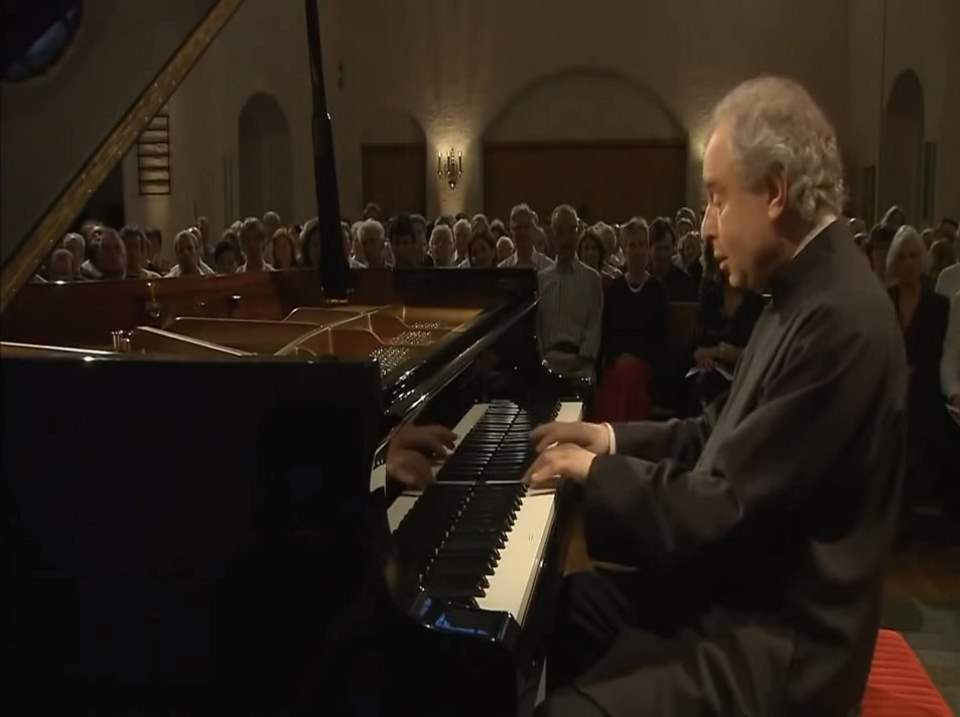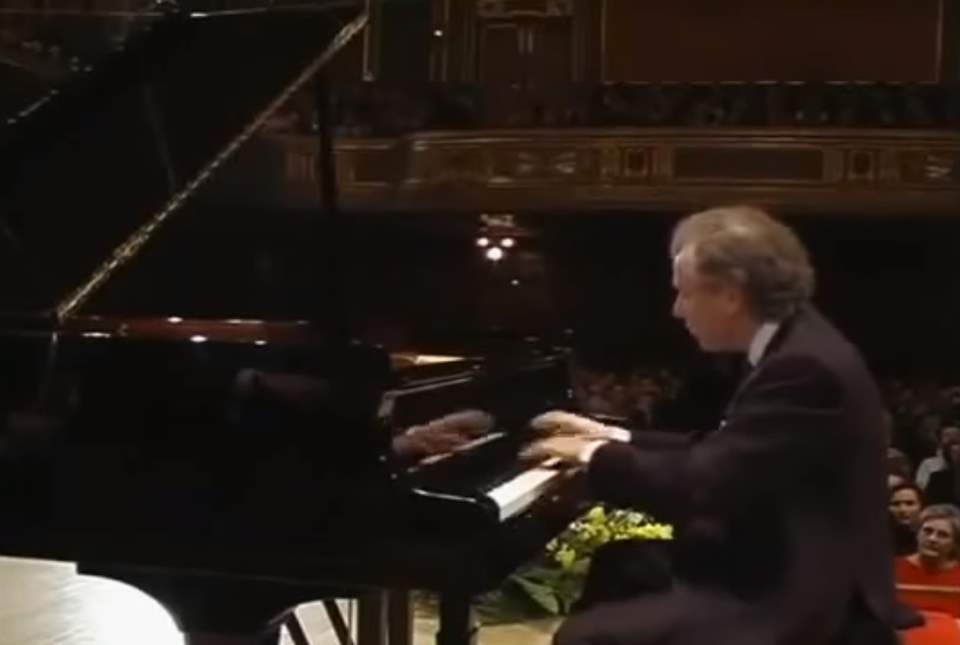Accompanied by the Royal Liverpool Philharmonic Orchestra, the Hungarian-born British classical pianist András Schiff performs Johann Sebastian Bach‘s Keyboard Concerto in D-Minor, BWV 1052 (originally Harpsichord Concerto in D-minor, BWV 1052). This performance was taken from András Schiff‘s performance at the Leeds International Piano Competition in 1975. Conductor: Charles Groves. Schiff was tied with the French classical pianist Pascal Devoyon for third prize at this competition (the Russian pianist Dmitri Alexeev won the first prize, and Mitsuko Uchida was the second).
Johann Sebastian Bach’s Harpsichord Concerto in D minor, BWV 1052
Johann Sebastian Bach’s Harpsichord Concerto in D minor, BWV 1052, stands as an epitome of Baroque keyboard literature and remains a staple in the repertoire for harpsichord and piano performers alike. While the piece is primarily associated with the harpsichord, its adaptability to other instruments like the modern piano also speaks to the timelessness and versatility of Bach’s compositional prowess.
The concerto was likely composed during Bach’s Leipzig years, around the 1730s, when he was the Cantor of the Thomaskirche and deeply involved in academic and public musical life. This period witnessed him composing a variety of pieces, from sacred cantatas to secular instrumental works, thereby contributing to a broader cultural milieu that valued both religious and worldly art forms.
The use of the harpsichord as a solo instrument is particularly striking, given that the instrument was more commonly relegated to a continuo role, merely providing harmonic support for other instruments. By elevating the harpsichord to a soloistic position, Bach revolutionized the instrument’s status. In doing so, he was able to exploit the full potential of the harpsichord’s capabilities, delivering intricate counterpoint and elaborate ornamentation that are hallmarks of his style.
The choice of D minor as the key of the concerto is also significant. D minor is a key often reserved for works of deep emotional intensity and complexity, qualities which this concerto embodies. Its construction is highly balanced and the harmonic language follows the conventions of tonality, a system where specific key relationships are employed to achieve a sense of tension and release. The concerto exudes both the grandeur and the intimacy typical of Bach’s compositional ethos, maintaining a delicate equilibrium between complexity and accessibility.
The orchestration primarily includes strings and basso continuo, serving as a harmonic and rhythmic framework over which the harpsichord weaves its intricate tapestry. The dialogue between the soloist and the orchestra is not just a mere exchange of themes but a sophisticated conversation, filled with layers of thematic development and motivic interplay.
For many performers, tackling the Harpsichord Concerto in D minor is a journey into the depths of Baroque emotion and technical virtuosity. The work requires not just technical skill but also a deep understanding of the stylistic and emotional landscape that Bach intended to portray. This dual necessity of virtuosity and expressivity makes it a fulfilling yet challenging piece for musicians.
For listeners, the concerto offers an immersive experience into the world of the Baroque-a world where emotional depth is conveyed through structured forms and intricate techniques. It’s a piece that has been analyzed, performed, and loved for centuries, and its enduring relevance is a testament to Bach’s genius.
Bach’s BWV 1052, is a monumental work that captures the essence of Baroque artistry, weaving complex counterpoint and emotional intensity into a unified whole. It uplifted the harpsichord from a supporting to a starring role, exemplifying how art can revolutionize perceptions and expand the horizons of what is deemed possible within a given medium.
Movements
With start times in the video:
- Allegro [00:00]
- Adagio [08:01]
- Allegro [15:35]
1. Allegro
The first movement of Bach’s Harpsichord Concerto in D minor, BWV 1052, opens with a sense of urgency and drama that immediately captures the listener’s attention. Written in the ritornello form, a standard in Baroque concertos, this movement is characterized by a recurring orchestral theme that alternates with episodes featuring the solo harpsichord.
The ritornello itself is a striking theme in D minor, introduced by the strings and the basso continuo. It serves as both an anchor and a point of departure, a unifying element that gives structure to the entire movement. The theme is robust and complex, embodying the tension and pathos often associated with the key of D minor. It establishes a mood that pervades the entire movement – a kind of intense, emotional gravitas.
But this isn’t merely a showcase for the orchestra; the harpsichord enters the scene with equally compelling material. Unlike the accompanimental role it often played in ensembles of the time, here it is unquestionably the star. Bach wrote passages that explore the full range and capabilities of the harpsichord. From intricate runs and arpeggios to delicate ornaments and expressive phrasing, the soloist is called upon to demonstrate not only technical prowess but also a profound emotional depth.
In the episodes where the harpsichord takes center stage, Bach explores a variety of textures and themes, displaying his hallmark counterpoint and intricate fugal elements. It’s as if the harpsichord is engaged in an intense conversation with the orchestra, sometimes taking the lead, sometimes responding, but always maintaining a harmonious dialogue.
The interchange between solo and ensemble isn’t just thematic; it’s a manifestation of Baroque ideals about the balance between the individual and the collective. This could be interpreted as an artistic reflection of the social and philosophical ideas of the time, where structured forms and collective harmony were deeply valued but individual expressivity was also celebrated.
Harmonically, the movement adheres to the principles of tonality, moving through closely related keys in a way that both creates and resolves tension. The harmonic journey is carefully crafted to maintain the emotional intensity throughout the movement, giving the entire experience a sense of cohesion and direction.
Rhythmically, the pulse is consistent, driving forward with a kind of relentless energy that propels both performers and listeners through the musical narrative. Yet within this steady framework, Bach employs rhythmic devices like syncopation and hemiola to create moments of surprise and delight.
2. Adagio
The second movement of Bach’s Harpsichord Concerto in D minor, BWV 1052, serves as an emotional and tonal counterweight to the frenetic energy of the first movement. Typically marked “Adagio,” this movement often unfolds at a slower, more contemplative pace, allowing for deeper emotional exploration. If the first movement is characterized by tension and complexity, the second offers a kind of reprieve, a moment to pause and reflect.
In this movement, the harpsichord takes on a softer, more lyrical role, bringing forth melodic lines that are imbued with a certain vulnerability and introspection. This contrast in mood showcases Bach’s emotional range as a composer, and his ability to navigate seamlessly between different expressive states. Even within the Baroque framework, which highly valued structural coherence and balance, Bach’s approach to emotionality was remarkably nuanced.
The orchestra’s role changes, too. Instead of contributing to the drama through intense ritornellos as in the first movement, the strings and basso continuo here provide a more subdued, often lush backdrop that complements the harpsichord’s lines rather than competing with them. In this setting, the relationship between the soloist and the orchestra is less about conversation and more akin to a poetic soliloquy supported by a sympathetic chorus.
Harmonically, the movement typically veers away from the home key of D minor into more chromatic territories. While the harmonic shifts are subtle, they are deeply affecting. This chromaticism contributes to the feeling of emotional richness, allowing for complex, often bittersweet, affective states to be communicated.
The slower tempo and lyrical nature of this movement allow for more ornamental passages in the harpsichord part. These ornamentations, such as trills and turns, aren’t just decorative; they’re emotionally charged elements that contribute to the overall mood. Such techniques were a hallmark of Baroque expressivity, providing performers with the latitude to inject their interpretations with a certain personal touch, so long as they adhered to the stylistic conventions of the time.
The structural form of the second movement is generally simpler than that of the first. While the first movement often employs ritornello form, the second might adopt a more straightforward A-B-A form, or ternary form, where an initial theme is presented, followed by contrasting material, and then a return to the opening theme. This form is effective for exploring contrasts, not just between the A and B sections, but also in terms of how the themes themselves are varied upon their return.
Though simpler in structure, the second movement is emotionally intricate. It often functions as the emotional core of the entire concerto, the heart around which the other movements circulate. Its introspective quality provides an opportunity for both the performers and the listeners to delve deeper into the emotive aspects of music, unburdened by the rhythmic and thematic complexities that characterize the other movements.

Related: Bach – French Suites [András Schiff]
3. Allegro
The finale of Bach’s Harpsichord Concerto in D minor, BWV 1052, serves as the culminating point of the concerto, bringing together the dramatic tension of the first movement and the emotional depth of the second in a rousing finale. Often marked “Allegro,” this movement is characterized by its brisk tempo, rhythmic vitality, and thematic exuberance.
Like the first movement, the third often employs the ritornello form, with a recurring orchestral theme that serves as a structural and thematic anchor. This ritornello bursts forth with an energetic vigor that is both engaging and uplifting, providing a stark contrast to the introspective qualities of the second movement. It re-establishes the D minor tonality with assertiveness, grounding the listener in the key and mood that opened the concerto.
The harpsichord’s role in this movement is nothing short of virtuosic. If the first movement demands technical mastery and the second emotional expressivity, the third requires both in spades. The harpsichordist navigates a torrent of intricate runs, arpeggios, and trills, all while maintaining a keen sense of dialogue with the orchestra. Here, the harpsichord reclaims its position as both a lyrical and a virtuosic instrument, demonstrating its capability for musical storytelling in a compelling fashion.
The dialogue between the harpsichord and the orchestra returns to the conversational mode prevalent in the first movement but with an added layer of exuberance and finality. This movement feels like a summation, a conclusion that draws upon the thematic and emotional material from the preceding movements and synthesizes them into a cohesive whole.
Harmonically, the third movement is often less adventurous than the second but retains a sense of urgency and drive. The harmonic progressions are tightly focused, gravitating around the tonic, dominant, and subdominant chords to give a sense of impending resolution. This relatively straightforward harmonic language contributes to the feeling of a triumphant conclusion, fulfilling the tonal expectations set up throughout the concerto.
Rhythmically, the movement is replete with syncopations, cross-rhythms, and other devices that imbue it with a spirited, almost dance-like quality. This rhythmic complexity does more than merely entertain; it serves as a powerful vehicle for expressing the joy or triumph that often characterizes the final movements of Baroque concertos.
Sources
- Harpsichord Concerto in D minor, BWV 1052 on Wikipedia
- András Schiff on Wikipedia

